#border (also in the 19th century)
Text
Lol today i learned (while doing German homework) that the whimsical Finnish word "tilpehööri" (= additional trinkets or random things that come along with something else) actually comes from the Swedish tillbehör which is equivalent to the extremely commonly used German Zubehör
#not exactly the same meaning but similar#petition to create 'tsupehööri'...#i already joke with my parents that i'm going to start speaking like 19th century finnish immigrants to america and/or ppl along the swedis#border (also in the 19th century)#(= speaking old-timey finglish/swennish where you make english or swedish words into finnish w pronunciation/spelling)#liisasin tänään tsaitungista että tsuukistraikki jatkuu vii'immä#etc#so yeah lets make this a thing pls /J#ashhdhj translations:#liisasin = [ich habe] gelesen#tsaitungista = in der Zeitung#tsuukistraikki = Zugstreik#vii'immä = wie immer#i'm having so much fun with this xDD#(so my example sentence would be 'i read today in the paper that the train strike keeps going like always')#languages#random
41 notes
·
View notes
Text
The 1812 poll continues to educate me on more historical events and developments happening in that year; although I think that most of them (including the Anglo-American War of 1812) ultimately tie into the global conflict of the Napoleonic Wars.
The Anglo-American War of 1812 is sometimes regarded as part of the Napoleonic Wars, although some events (Britain and France harassing USAmerican shipping) are more directly tied to the conflict than others... sort of? The USA trying to invade Canada dates back to our war of independence, tbh, although in 1812 the hope was that the British would be distracted by Napoleon.
The Dey of Algiers in 1812, Haji Ali, also opportunistically jumped into the Anglo-American War of 1812 on the side of the British, creating an Algierian theatre of war in 1814-1815. Clearly this was related to earlier conflicts between the USA and the Barbary States, but like... entering the War of 1812, really???
The North American theatre of war is something that I increasingly see as a conflict not so much between British and American interests—or other European colonial powers, like Spain—but a settlers vs. Indigenous nations conflict that dates back to the Seven Years' War. What would become the northwest theatre of the War of 1812 involved US States and territories that were already militarised against Indigenous people.
#war of 1812#napoleonic wars#shaun talks#just a whole jumble of thoughts about#military history#would have loved to go the '60 years war in ohio' talk#also the usa-canada border wasn't fully demilitarised until the late 19th century iirc#quick lads while the canadians have let their guard down!
27 notes
·
View notes
Note
(sorry in advance for the more personal ask, you're the most intelligent person i know of when it comes to these things)
genuinely, how are we supposed to find the strength to go on? it feels like capitalism has won. only a few decades ago my country was openly and proudly socialist, and now we're nothing but an american military base with an economy. everything's been privatised, the unions are broken, the people are starving, and we keep voting for more of this! people are gleefully begging for yet more exploitation! sometimes it feels there's not a drop of class consciousness to be found in the entire country, and that it's pointless to even hope for change. how can i stay sane?
The class struggle is not a team sport which either side can win or lose. It is a historical and economic process, one that's inevitable. As long as capitalism exists, there will be a social majority of workers it must exploit, alienation will still happen, and a portion of these workers will be aware of this fact. The class struggle is also a long process, one that, most of the time, is imperceptible to the individual in physical and time scale. Only sometimes, it accelerates to dizzying speeds and the conditions necessary for taking power are met. We can talk about victories and defeats, but we can't lose sight of the fact that those "only" are points in time, momentaneous advances or retreats in the process that is the class struggle, but they never mean the paralization of this process.
We can only really talk about the bourgeoisie taking power and creating the first properly capitalist states in the late 18th century and early 19th, but the bourgeoisie had lead or taken part in attempts at or glimpes of revolution as far back as the early 16th century. The bourgeoisie never really had an unifying theory of the class struggle, most were never really fully conscious of it. But they still eventually took power, once the development of the national economies advanced so far that it forced the replacement of the feudal mode of production, the bourgeois revolutions became inevitable. Marx and Engels only ever saw one real attempt at the proletariat taking power, in the Paris Commune of 1871, but it only ever lasted a few months. They both were long dead when the first actually (relatively) long-lasting instance of the proletariat in power broke the oppressor classes' veneer of invincibility.
When Marxists talk of inevitability it is not in a conspiratorial manner, or an expression of satisfied optimism, we never mean that "one day the capitalists will get what's coming to them", in a vague way. We mean that, only if communists continue to work towards the revolutionary organization of our class, is a complete overthrow of capitalism inevitable. We should all do an exercise is historical perspective when it comes to analyzing progress, take the Marx and Engels example from the previous paragraph, they never got to see an effective application of their theories. Class consciousness will fluctuate continuously, it always has. The bolshevik party in 1913 had nothing to do with the party that lead the October Revolution, and 8 years after the defeat of the 1905 revolution, I bet many felt like their work was hopeless. My point is that, while the borders of the Communist Party may shrink, grow, or even disappear, and while we might be savagely oppressed, no system of oppression has ever lasted forever.
When it comes to revolutions, there are objective and subjective conditions. The objective we can never control; it's the stability of capitalism, the characteristics of its suprastructure, if there is a crisis or not. The subjective is what's under our control; our own work as communists, the state of the revolutionary party, the degree of influence of communists at the core of the working class. These two sets of conditions interact with one another, with the objective conditions influencing the possibility of development of the subjective conditions much more than the reverse. What makes you hopeless is in part the objective conditions. Capitalism is quite stable right now (though not as much as it ever seems), and, for now, we can't do much about it, because the subjective conditions, the other part of your homelessness, are also very delayed. But these we do have control over, at first very little, but as they improve, the control we have over them also increases. Essentially, friend, all we can do is prepare our class, do our best to gain more workers to our cause, bit by bit, so that once capitalism shows one of its cracks, we can be ready to pry those cracks open and bust the whole system. The Russian soldiers in WW1 were already discontent when the bolsheviks began to agitate up to the trenches, Mao's guerrillas grew to an army taking advantage of the deep fragmentation China suffered throughout the first half of the century, etc.
Once again, class struggle is not a straight line that we move in two directions. It is a complex space. The overthrow of the USSR was a very profound blow to revolutionary organizations all around the world, of course, but the state of communism in general in 1995 was still in a much better position than it was merely 90 years prior. Every defeat also sharpens the tactics and strategies we use. Eastern Europe (where I assume you're from) did use to be socialist, and those worker's states were overthrown. But you are still in a better position than a communist in the interwar period, facing borderline fascistic dictatorship and a future of Nazi-Fascist occupation. They did not have any precedent or much practical experience to learn from, but you do. Every day that we delay work, even in the most hopeless of contexts, is a day more that our grandchildren will have to bear in capitalism, and a day more they're deprived of true freedom and self-government
382 notes
·
View notes
Text
Many fans often envision The Conquerors in a Byzantine fashion, and it's quite fitting. The Byzantine Empire, also known as the Eastern Roman Empire, persisted as the continuation of the Roman Empire, surviving the challenges that led to the fall of the Western Roman Empire in the 5th century AD. Similarly, The Conquerors, the Targaryen family, survived the Doom of Valyria, making them the heirs and continuation of the Valyrian Freehold.
SO, If we picture ancient Valyrians donning attire akin to 1st-century Romans, like stolla dresses and palla cloaks for women and togas for men, it logically follows that The Conquerors, as inheritors of the empire, would don Byzantine clothing in their portrayal.
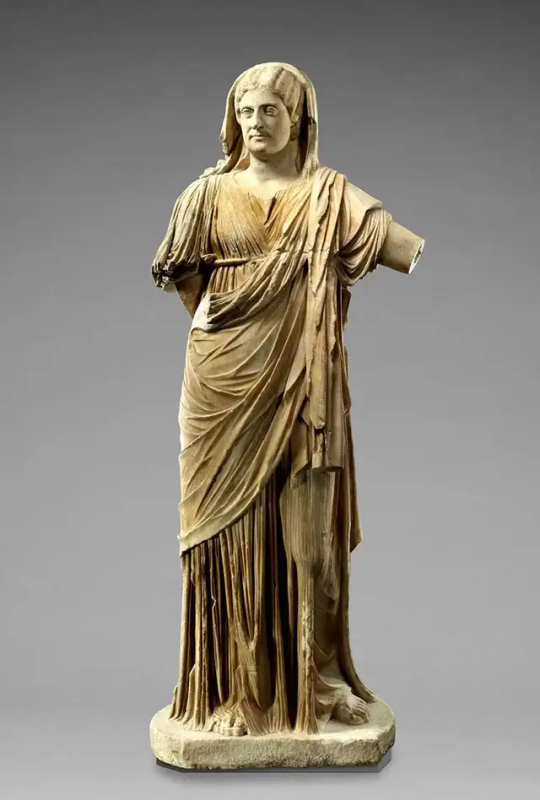
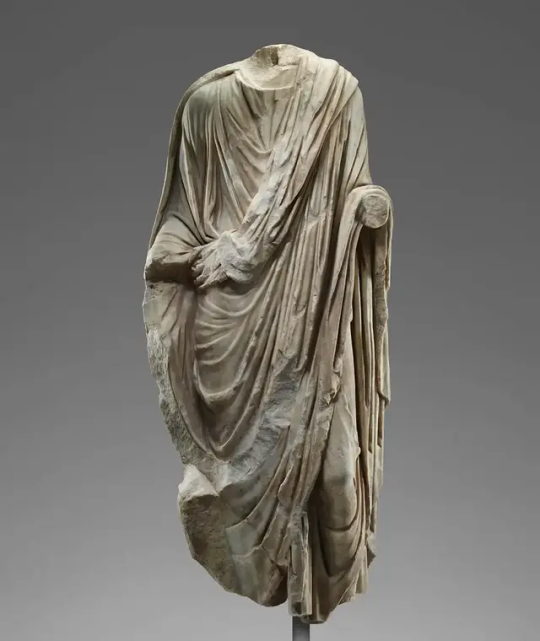
NOW! although the 6th-century Byzantine imperial costume boasts simplicity in silhouette, draping, and cut, it is truly elevated by its lavish bejeweled and embellished details.
Take, for instance, Empress Theodora's state costume: a white stola adorned with intricate gold and jewel embellishments at the hem, a purple paludamentum heavily embroidered with a luxurious gold border, and a prominently jeweled collar crowning the cloak—an iconic symbol of Byzantine fashion. Completing her regal ensemble is a headdress with cascading ropes of pearls. Meanwhile, her ladies in waiting don similar attire, albeit with fewer embellishments.

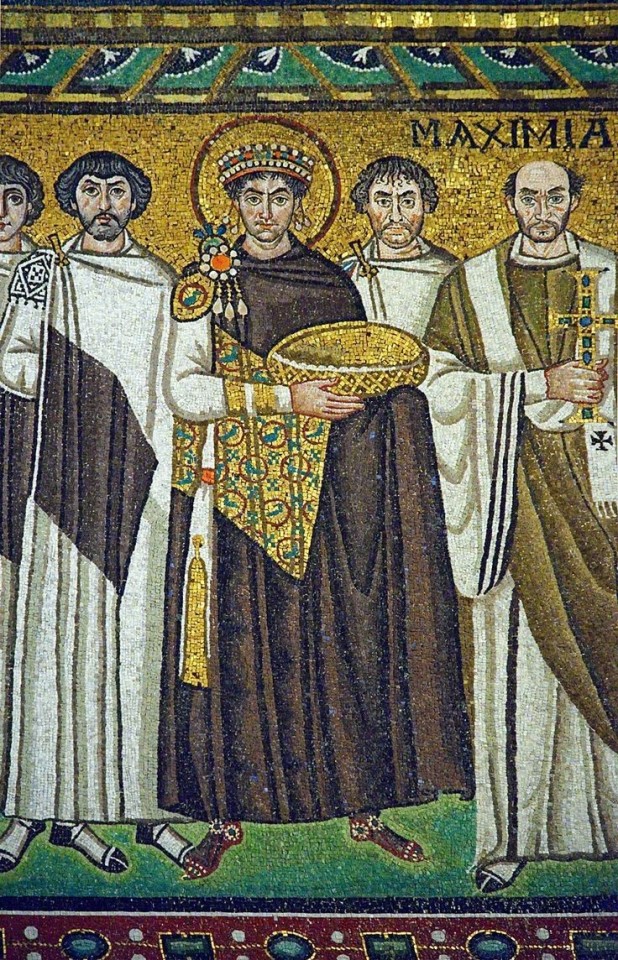

All in all, Byzantine fashion is all about garments embroidered with gold and adorned with pearls and jewels.
And it is this extravagant opulence I wanna see The Conquerors in - Aegon adorned in a blood-red paludamentum pinned gracefully on his right shoulder, while Visenya and Rhaenys don heavily bejeweled collars and intricate hairstyles.
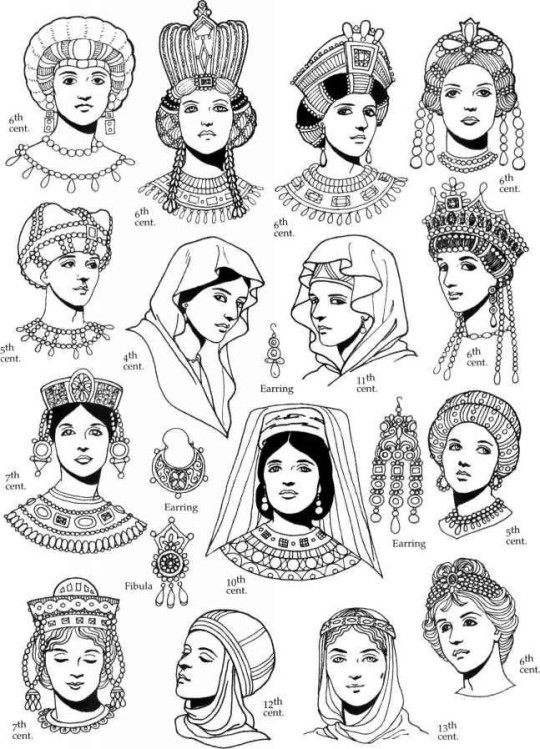
However, it doesn't have to be overly historically accurate. I believe that as long as certain 'iconic' Byzantine fashion elements are incorporated, the silhouette can be altered. Take, for example, the 19th-century depictions of Empress Theodora:
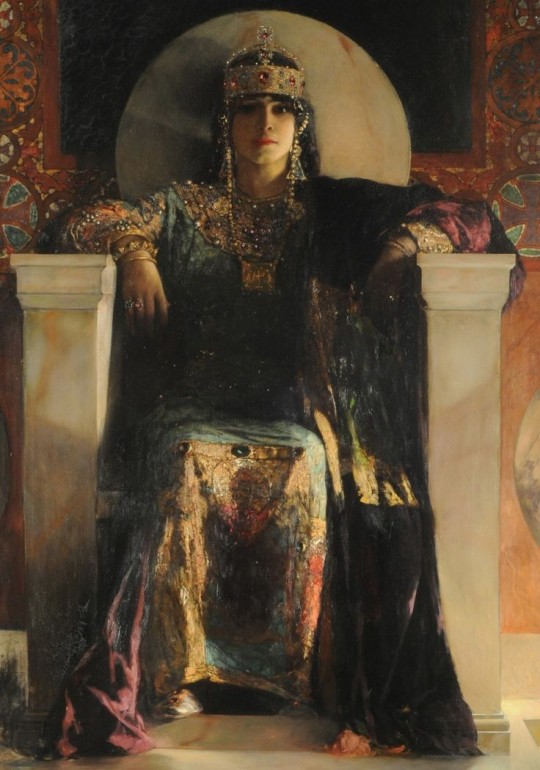
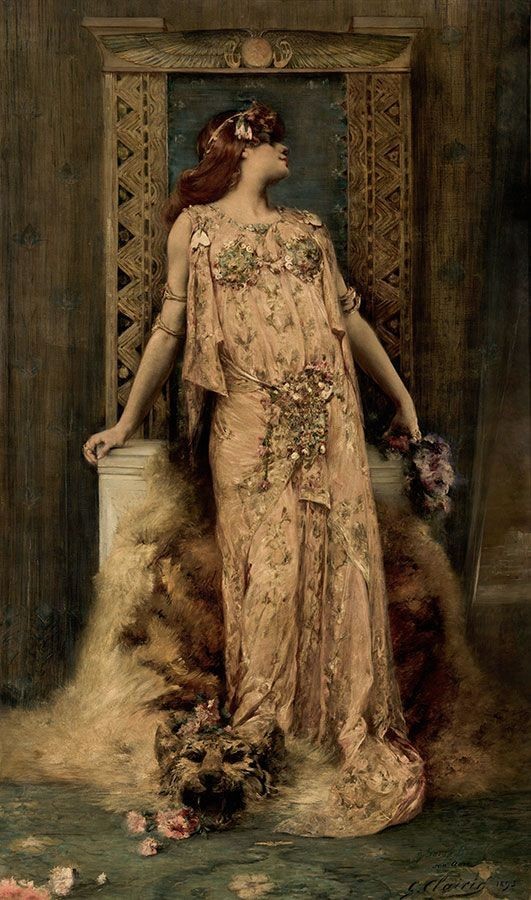
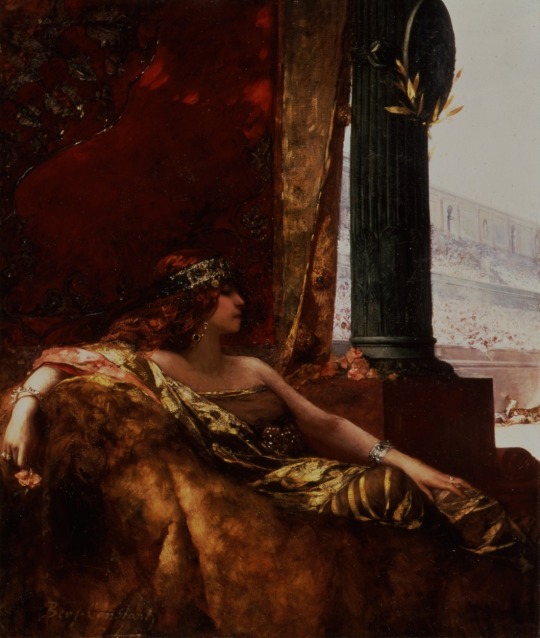

While most of them lack accuracy (with Jean-Joseph Benjamin-Constant's version being the closest to historical credibility), they successfully capture the essence of luxury, gold, and opulence.
Conclusion: I think if I were to draw The Conqueror sisters, I wouldn't necessarily adhere strictly to the historically accurate shapeless, modest silhouette. However, I would definitely strive to convey the essence of luxury and ornamentation in my depiction.
#The Conquerors#asoiaf#aegon the conqueror#visenya the conqueror#rhaenys the conqueror#fashion thoughts
280 notes
·
View notes
Text
The Best News of Last Week - June 20, 2023
🐕 - Meet Sheep Farm's Newest Employee: Collie Hired After Ejection from Car!
1. Border Collie ejected from car during Sunday crash found on sheep farm, herding sheep

Tilly, the 2-year-old Border Collie who was ejected from a car Sunday during a crash, has been found. He was found on a sheep farm, where he had apparently taken up the role of sheep herder.
According to Tilly's owner, he has lost some weight since Sunday's crash and is now drinking lots of water but is otherwise healthy.
2. After 17-Year Absence, White Rhinos Return to the Democratic Republic of the Congo
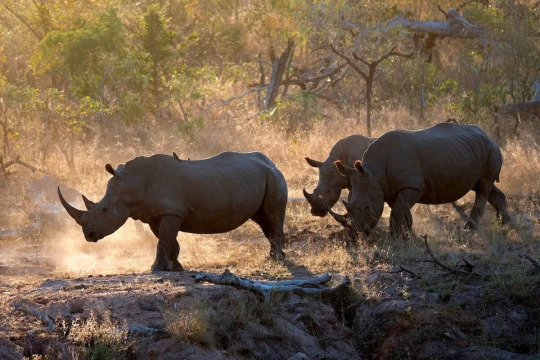
The Democratic Republic of the Congo (DRC) recently welcomed the reintroduction of 16 southern white rhinoceroses to Garamba National Park, according to officials. The last wild northern white rhino was poached there in 2006.
The white rhinos were transported to Garamba, which lies in the northeastern part of the country, from a South African private reserve. In the late 19th century, the southern white rhino subspecies was believed to be extinct due to poaching until a population of fewer than 100 was discovered in South Africa in 1895, according to WWF.
3. UK to wipe women’s historic convictions for homosexuality

Women with convictions for some same-sex activity in the United Kingdom can apply for a pardon for the first time, the Home Office has announced.
The Home Office is widening its scheme to wipe historic convictions for homosexual activity more than a decade after the government allowed applications for same-sex activity offences to be disregarded.
It means anyone can apply for a pardon if they have been convicted or cautioned for any same-sex activity offences that have been repealed or abolished.
4. Study shows human tendency to help others is universal

A new study on the human capacity for cooperation suggests that, deep down, people of diverse cultures are more similar than you might expect. The study, published in Scientific Reports, shows that from the towns of England, Italy, Poland, and Russia to the villages of rural Ecuador, Ghana, Laos, and Aboriginal Australia, at the micro scale of our daily interaction, people everywhere tend to help others when needed.
5. In a First, Wind and Solar Generated More Power Than Coal in U.S.

Wind and solar generated more electricity than coal through May, an E&E News review of federal data shows, marking the first time renewables have outpaced the former king of American power over a five-month period.
The milestone illustrates the ongoing transformation of the U.S. power sector as the nation races to install cleaner forms of energy to reduce greenhouse gas emissions from fossil fuels.
6. Iceland becomes latest country to ban conversion therapy

Lawmakers in Iceland on June 9 approved a bill that will ban so-called conversion therapy in the country.
Media reports note 53 members of the Icelandic Parliament voted for the measure, while three MPs abstained. Hanna Katrín Friðriksson, an MP who is a member of the Liberal Reform Party, introduced the bill.
7. The temple feeding 100,000 people a day

Amritsar, the north Indian city known for its Golden Temple and delicious cuisine, is also renowned for its spirit of generosity and selfless service. The city, founded by a Sikh guru, embodies the Sikh tradition of seva, performing voluntary acts of service without expecting anything in return.
This spirit of giving extends beyond the temple walls, as the Sikh community has shown immense compassion during crises, such as delivering oxygen cylinders during the COVID-19 pandemic. At the heart of Amritsar's generosity is the Golden Temple's langar, the world's largest free communal kitchen, serving 100,000 people daily without discrimination. Despite a history marred by tragic events, Amritsar continues to radiate kindness, love, and generosity.
----
That's it for this week :)
This newsletter will always be free. If you liked this post you can support me with a small kofi donation:
BUY ME A COFFEE ❤️
Also don’t forget to reblog.
1K notes
·
View notes
Text
Malleus is 178, and if the story of Twisted Wonderland is set in 2020, he was born in 1842, you know, the very middle of the 19th century. In the human history of the west, we associate those times with progress and revolutions in art (impressionism in france), science (darwin), geopolitics (japan opening its borders)… these are the first hundred years of the mass society, modernity, in constant expansion. There was a conscious shift in paradigms. Everything started happening so fast.
Malleus’ birth must have symbolized those same values for the fey of the night. It was probably a miracle to the people, seeing as it was confirmed a dragon egg hatches with the help of its parent’s love. Because of reasons that haven’t been confirmed yet (many speculate Lilia drained his magic for a few hundred years), the little prince is born and he will bring a new era when the time comes. It seems the pressure is on for Malleus to act older than he is. As such, it’s no surprise that Malleus will prematurely refer to himself as a king, as evidenced in one of his magic3 lines as well as one of his dorm card homescreen lines. Lilia also refers to him as a king in the Savanaclaw localization.
His physicality doesn’t help; I don’t need to remind you that Malleus already is regarded as one of the most powerful mages ever. In a voiceline, Malleus says that to be a leader, all you need to do is show your power. He and many others seem to associate power with maturity… but I see Malleus’ as modernity, constant change, which, in the wake of the mass society during the 17th century, is young. He still has many many years to live and his strength will only be greater. This is not yet his prime. But that sheer power is inherited from a family tree which is ancient and whose roots are his very veins. The wrath of Maleficent when she cursed Aurora is Malleus’ heartbeat. If historiography can’t convey myths and legends and tales accurately, Malleus’ hands, his wings, his eyes will remind all of the Thorn Fairy’s former glory.
But if the constant fandom jokes about Malleus being a manchild are anything to go by, we all know he is mentally a boy. He is young, you know, he is a paradox and an anachronism; his psychology evokes the constant anxiety and fear of judgement of the middle ages, the misery, the catacombs, the plague, it seems like we are at the very start of the concept of civilization, entire peoples are decimated by illness, and this goes on for a thousand years. Malleus is jaded, bored, he is far too powerful and everything is so dull, the days blend together and he insists he is a grown man and he needs no patronizing, he sees those around him as babies, but the middle ages are decay and artistically stunted, much like Malleus’ mind, because he doesn’t want to lose, he’s afraid, and when you are a child everything you feel is so vivid and intense and you feel like everyday is the end of the world.
So to answer the question; is Malleus young or old? The lines are blurred. He doesn’t know anymore.
522 notes
·
View notes
Note
Hi, so as far as my family knows, our family name is Catalan, but we can't trace our family line before we moved to Cuba. So I was wondering if many Catalan people moved to Cuba when it became outlawed in Spain? Or in the times leading up to it being outlawed?
Thanks!
Hola!
Cuba is one of the countries with a largest Catalan diaspora. Catalan people were forbidden from going to the Americas (who were Castillian colonies) until the year 1778, and it still took a while for people to start going in large numbers.
Catalan people first migrated to Cuba in the 19th century, a few were rich people who went there for commerce (even involved in slave traffic! 😱) and soon more poor people started going, too, after their lives were turned upside-down by the phylloxera pest. Back then, in many parts of the Catalan Countries most people worked in the vineyard fields or related trades that had to do with winemaking, but in the mid-1800s the phylloxera (an insect from North America that destroys vineyards' roots) arrived to Europe and destroyed the fields. The effects of the phylloxera were absolutely devastating: thousands of people lost all their vineyards, whole areas lost their income, poverty reached the extreme. With the countryside ravaged, people desperately looked for new jobs, and many found that the only option was to emigrate. The vineyard-making rural areas suddenly lost population, who were going to the cities or abroad. Most of these Catalan farmers who went abroad went to Cuba, because it was seen as a land of opportunity where people could make a good living. Usually (and like many economical migrants nowadays), they had the idea that they would go, make money, and come back home, but (not unlike many economical migrants nowadays) most did not make that much money, and decided to stay in Cuba. Many Catalan immigrants in Cuba ran corner shops, they were so poor that they slept behind the shop's counter because they didn't have any other home than the shop. I have read that in 19th century Cuba, people even used the expression "to go to the Catalan on the corner" (el catalán de la esquina) or just "to go to the Catalan" (el catalán) to mean going to a corner shop (same as now many European countries say "to go to the Pakistani"). Besides these ones, a strong network of Catalan merchants also established itself in Cuba, trading with sugar and coffee.
Of course, the "corner Catalans" could not afford to come back, but the ones involved in slave trading or commerce with products grown by slaves often could. The poverty at home and the return of these rich people created the image of the "indiano" or "americano", meaning someone who had gone to Cuba (or, less commonly, Puerto Rico), had become rich, and had come back dressed in elegant fashionable clothes, the man smoking a thick cigar, and built a beautiful house in his hometown. The "indiano" became part of the collective imagination, and was a very prestigious person. These "indiano-style" buildings (they sent the command to start building the house from America, before coming back) and the presence of the "indianos" promoted the idea of Cuba as a place of opportunities even more. Still nowadays, in Catalan we have the expression "fer les Amèriques" ("to do the Americas") meaning to get very rich.




Examples of indiano houses in Begur and Cadaqués.




Examples of indiano houses in Sitges.
And the same happened the other way around a bit later: in Cuba, art nouveau was introduced in large part by Catalans, and the early houses built in this style were called "catalanadas" by Cubans.
In Sitges, there's even a pair of "giants" that represent these "indianos". "Giants" are a traditional element of Catalan folk culture, they're hollow figures that represent the mythical founders of a town or someone important from their local history or legends. In the case of Sitges (like in many more towns that used to be the border between Muslim and Christian kingdoms when they were founded), it's a pair of Muslim nobles and Christian nobles from the Middle Ages. But in the 1960s they decided to add another pair of smaller giants to represent the "indianos". This goes to show how the idea of the "indiano" almost as a mythical category has survived.


The "americanos" giants in Sitges.
For these reasons, there is a long list of famous Cubans of the Catalan diaspora, including the president of the first independent Cuban constitutional assembly (Asemblea de Guáimaro) Bartolomé Masó, Facund Bacardí (founder of the Bacardí rum company), the revolutionary and Cuban independence hero Leoncio Vidal, the musician and conductor Xavier Cugat, the poet José Martí, la reina del bolero Olga Guillot, the dancer Aurora Bosch, the anti-Fulgencio Batista intellectual Mario Llerena, the anarchist thinker Fernando Tarrida del Mármol and his uncle the Cuban independence general Donato Mármol, among others.
Besides Catalan-Cubans being involved in Cuban independence from the Spanish empire, they also were involved in the Catalan independence movement. For example, the flag of Catalan independence (estelada) was created in the early 1900s by a Catalan in Cuba, who used the triangle of the Cuban flag that means independence.


The Cuban flag and the Catalan independence flag.
The Catalan diaspora in Cuba also created the first "Casal Català" ("Catalan house") in 1840 in Habana. A Casal Català is a social centre where Catalan emigrants meet, for example to celebrate the Catalan holidays, and also open Catalan culture to other people, such as by offering Catalan classes. Nowadays, there are 128 Casals Catalans in all 5 continents.
Another way in which Cuba has had a deep mark in Catalan culture is the music genre havaneres, which are melancholic songs that fishermen, sailors and emigrants sang.
The other moment with a highest number of Catalan emigrants (refugees and exiles) was after the fascists' victory in the Spanish Civil War (1939), but few of them went to Cuba then. Most went to Mexico, Venezuela, and France, and some also to Chile, Argentina, Colombia, and to a lesser extent the UK and the USA.
54 notes
·
View notes
Text



Victorian Sunderland Lustre Frog mug printed with ships portrait of a Hull Whaling Ship & inscribed 'Truelove from Hull' 'There's sunshine on the sea my love. There's beauty oe'r the skies. But fairer seem thy looks my love and brighter are thine eyes', within orange borders, H12cm. 19th century
The 'Truelove' was built in Philadelphia in 1764 and came into English hands during the American War of Independence where she had been used as a privateer. She was sold to John Voase, a wine merchant and ship owner in Hull, and was converted into a whaling ship. The 'Truelove' made over 80 voyages, killing over 500 whales as well as seals, walruses, narwhals and polar bears. The 'Truelove' also brought wine from Oporto and for 9 years she engaged in general trade with the Baltic ports. In 1835 the 'Truelove' was one of a fleet trapped in ice in Melville Bay, Greenland.
Twenty of the fleet were crushed but 'Truelove' survived unharmed. Captain Wells described her as 'handy as a cutter, safe as a lifeboat, and tight as a bottle'. The 'Truelove' was the last of the Hull whalers and sailed alongside the steam powered whaling vessels in the 1850's and 60's. In 1873 she travelled to her home port of Philadelphia and was presented with a flag in honour of her 'birth' there 109 years earlier.
After her visit to Philadelphia there were calls to have her made into a floating museum but this never came about and she ended her days as a bulk on the Thames before she was finally broken up in the late 1890's. The 'Truelove' was in use for over 130 years, outliving all other vessels of her class who were built at the same time
227 notes
·
View notes
Text

Rob Little
U.S. Route 50 in Nevada, stretching approximately 408 miles from the California border near Lake Tahoe to the Utah border near Baker, is famously known as "The Loneliest Road in America." This route traverses diverse landscapes, including the scenic Sierra Nevada mountains, vast desert expanses, and remote mountain ranges. Major cities along the way include Carson City, Fallon, and Ely, each offering unique attractions such as historical sites, the Nevada Northern Railway Museum, and gateways to natural wonders like Great Basin National Park. The road also passes through historic mining towns like Austin and Eureka, preserving 19th-century charm and providing a glimpse into Nevada's rich mining heritage.
Travelers on Route 50 should prepare for minimal traffic, limited cell service, and stretches with few services, underscoring the importance of planning fuel stops and carrying extra supplies. Despite its isolation, the highway offers a wealth of recreational activities, including hiking, camping, off-roading, and stargazing, particularly near landmarks like Sand Mountain Recreation Area and Lehman Caves. Celebrated for its historical significance as part of the Pony Express and Lincoln Highway, Route 50 presents a unique and serene driving experience through some of America's most striking and solitary landscapes.
56 notes
·
View notes
Text

My town celebrates its birthday in September. The first known settlement of people on the territory of the modern town is the local mound mentioned by Guillaume de Beauplan as early as the 1st half of the 17th century, where the crossing point was fortified and where Zaporozhian Cossacks gathered for military councils. The village itself was first mentioned in 1750.

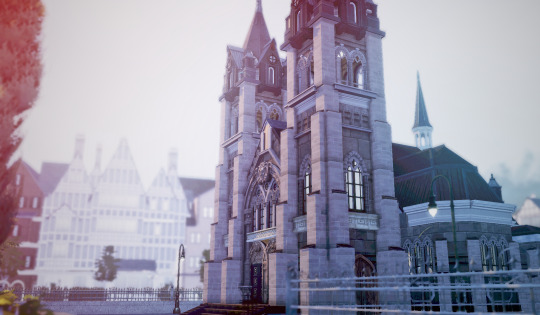

Active development of the town began at the end of the 19th - beginning of the 20th century, when a metallurgical plant was built within its borders. It was started by a society whose founders came from Belgium, Poland, Germany and France. And it was with the funds of the workers and employees of the Plant with the participation of the Metallurgical Society that the church of St. Nicholas was built.


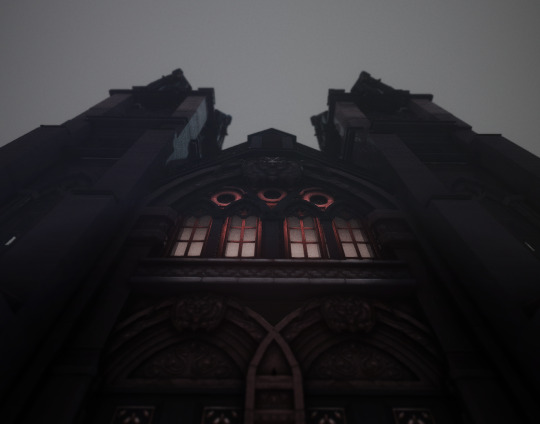
The church, built in the Gothic style, impresses with its silhouette at first glance. Its graceful turrets with upward spiers, massive doors with wrought iron ornaments and large arched windows create an impression of grandeur. This church belongs to the Roman Catholic Church and is one of the few examples of such architecture in Eastern Ukraine.

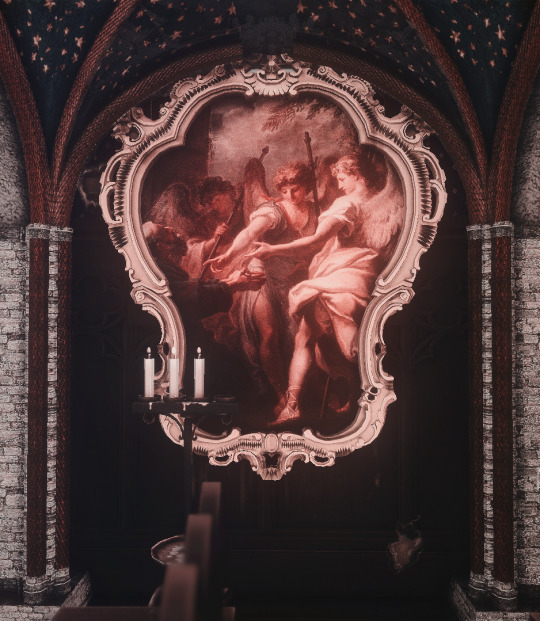

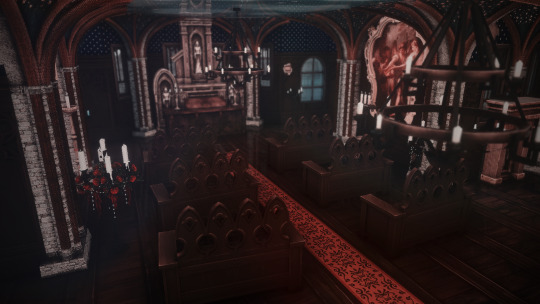

I changed the interior to a more gloomy and gothic one, since in the original there are only white walls and a few benches inside.
Also this time you don't need to install insane amount of mods: only 4 positions for the facade and a bit more if you also wanna have decorated interior.
More info, screenshots and DOWNLOAD here.
CC credits:
•@thejim07 •@anachrosims •@lilis-palace •The Regal Sim •@zx-ta •@annadedanann
#sims#the sims 4#sims 4#ts4#ts4 simblr#simblr#sims 4 build#ts4 build#sims 4 historical#the sims 4 historical#the sims 4 screenshots#ts4 goth#the sims 4 lots#sims 4 lot#ukrainian architecture#my sims buildings
285 notes
·
View notes
Text
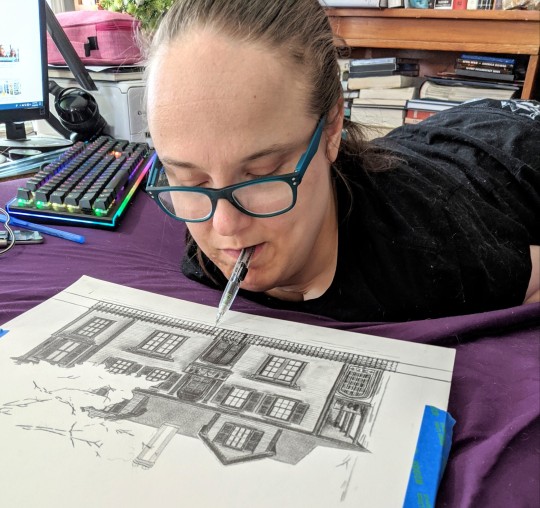
Hi everyone! I wanted to introduce myself. I'm Jessica and I was a previous user of Tumblr before it was bought. I decided to come back.
Today I'm not so much a fandom person (my first account was a Supernatural and Destiel vibe) as I am living my "real" life as an artist, author, historian, and disability rights activist. I'll be 42 in February and I live on the border of Ohio and West Virginia - like, literally on the border. I can almost throw a rock and hit West Virginia from my apartment building. Living here after spending over twenty years in Georgia has been a fresh change. Georgia is not a great place for people with complex disabilities like mine. I get much better medical care and access to state services here in Ohio, which is why I came here. My ancestry is Appalachian anyway, so this does feel like home in a strange way.
My art is what I do the most. This is me doing a commission order a few years ago.

You're immediately wondering about my disability and why I do everything with the tools in my mouth. I was born with a condition called Arthrogryposis and that just simply means my joints have very little range of motion. Much of my body is stiff. So I taught myself to play with my toys, markers, etc., with my mouth rather than my hands before I could even read or go to school. It was natural for me. I live a happy life and I'm not upset about being born with this disability. You don't have to feel sorry for me because I don't feel sorry for me.
At this stage in my life, I'm working on art commission number 91 with about 50 more on my wait list. My work specializes in black and white pencil portraits, mostly of different historical periods. Most of the art people order from me has to do with my ability to interpret their previous lifetimes (yes, reincarnation) as well as introducing them to their spirit guides. I do regular art with no spiritual complex as well, like family portraits, friends portraits, pet portraits, architecture, fan art, original characters, some fantasy, witchcraft, folk magic, paranormal, historical events, etc. I'm heavily trained in realistic very detailed portraits, so if you're looking for anime or cute illustrations, I'm probably not your woman.
This is the last commission I finished.

This is an interpretation of that customer's spirit guide as they appeared before they died. This is "my style" of art, as they say. I like to do color art too but I finish black and white orders much faster.
Besides art, I'm a lifelong student of 19th century history in America focusing on women's roles, families, social issues, disability history, and LGBTQIA+ history. I was in school to specifically become an antebellum and Civil War historian before chronic illnesses forced me to drop out. Higher education 20+ years ago was a casserole of nonsense when it came to helping disabled students succeed. Don't get me started.
I'm also a lifelong paranormal researcher focusing mostly on hauntings tied to antebellum and Civil War America including old folklore. My mother and grandmother were Missouri folk magic practitioners. I was raised in an understanding of the unseen world. I also collect reincarnation cases from the Civil War period sparked by my own case from that time. I'll talk about that elsewhere if you want.
Follow me here if you like. I'm just getting started. I have to relearn how to use this app.
-Jessica
Shop: etsy.com/shop/ArtByJessicaJewett
If you're not interested in art, I also accept tips if you enjoy my content. I'm at $ArtByJessicaJewett on CashApp, at Jessica-Jones-1002 on Venmo, and PayPal.me/ArtByJessicaJewett on PayPal.
312 notes
·
View notes
Note
Could I humbly request Dullahan (basically a headless horseman with a whip made from a spine) Jason giving reader a ride on Halloween? If not, that’s okay.
what a delightful prompt anon! i took some batman-inspired liberties here, so jason is more of a regular headless horseman than a dullahan specifically (kept the whip tho bc man, what a badass weapon). but omg it fits him SO well. hope you like it!
headless horseman!jason todd x gn!reader. spooky themes. i guess it's a different time period -- i was imagining 19th century. reader knew jason before he died.
send halloween requests!!
****
You should've taken a carriage.
That's all you can think as you cross the border from Clarence County to Gotham County. You've been walking for an hour, and you're only just entering Gotham. The sun went down ages ago.
It's mostly wilderness outside of the city, and it's generally safe. Rich folk build vacation cabins in these woods. Others hike and fish along the river.
You still should've taken a carriage. Even if no people pose a threat to you out here, the forest is still dangerous. Bears. Snakes.
...Things not of this world.
No, you can't think that way.
Your basket of farm goods makes your arm ache. You switch it to your other hand. You're beginning to think that making this trip wasn't worth it at all. Certainly not if a bear mauls you.
A twig snaps and you jump about three feet in the air. You skitter away from the tree line, heart beating fast.
You wait. You have a glass bottle of milk to throw at whatever comes out of the woods.
Nothing. Silence. The trees might as well be dead.
Slowly, you untense, muscles slowly going slack. A twig probably didn't even snap; it's only your imagination. Yes. Right.
You tuck the milk back into your basket and adjust yourself, continuing your trek.
"Awful late to be out."
This time, you do throw the milk bottle. It lands with a thud in the soft dirt. The voice speaks again. He sounds amused.
"You missed me."
You whirl around and gawp. How had you missed a man on a horse? Surely you would've heard footsteps or the jingle of the straps.
The horse is huge, with a shiny, black coat. Its rider is proportionally large, broad shoulders straining his crimson hood. You can't make out his face, the opening nothing but a void. You squint, but grow dizzy when you look too hard.
It's such a strange thought, but your first instinct is that you know the rider. Intimately so. Like an old friend.
The horse is a shadow, the edges of its mane blurry. It nickers and drags its hoof over the dirt. It also has a hood, so you can't make out its face either.
The hooded figure watches you from his horse. At least, you think he does.
"Are you lost?" he asks. His voice echoes strangely, like it's coming from underground.
"No," you say immediately. "I'm on my way back to Gotham."
Most people have enough sense not to challenge Gotham citizens.
He tilts his head. You wish you could see his face.
"I can give you a ride. I'm headed there myself."
There is a red knight's helmet tied to the saddle. You look at it, then at him.
"I'll manage," you say. "I know my way."
"It's dangerous to travel alone on foot. Especially so late."
He dismounts the horse. Even on the ground, his presence is overwhelming. There is a long, bone-white whip fastened to his hip. Are those...?
"What's in the helmet?" you ask.
"Why do you think there's something inside?" His voice echoes again.
He goes and retrieves the bottle of milk you threw. It isn't cracked, which is fortunate. He opens the basket hooked over your arm and gently places the milk inside. Your heart pounds the entire time.
"I won't hurt you," he says, stepping back. "Gotham is my city. You are mine to protect."
"Gotham belongs to the Bat."
"Not for much longer," he says, almost snarling.
You look at the horse, which has been eerily still. The moon is high in the sky. Stars dance outside of the city smog.
"If it makes you feel safer," he says, voice softer. "You can hold my whip. If I do anything you don't like, you can be sure I won't do it again."
You don't like that idea; you hope you don't have to use the whip on him, though he is a stranger. But you like his voice, even if it echoes oddly. And you like how gentle he is, how calm his horse remains. You are sure he won't hurt you, even though there is no proof for you to confirm that.
You extend your hand.
"Alright," you say. "Please take me home."
He pushes you onto the horse, who doesn't even stir when you get on its back. Then he mounts with ease. He slides his whip out and gives it to you; on further inspection, you realize it's a spine. The horse takes off at a gallop, and you cling to the hooded man so you won't fall off.
"Are you a soldier?" you ask, wind biting at your face. He is cold but full of strength.
"I was."
"What should I call you?"
He thinks for a moment, steady under the brutal pace.
"You may call me Red Hood."
"Haven't you got a name?" you ask.
"I did," Hood says. "I'm not certain that it's mine anymore."
He sounds young. You wish you could see his face.
You arrive in Gotham sooner than you should, even on horse. Hood dismounts again and helps you down, strong hands on your waist. You land on the ground in a whoosh, and Hood holds you for a second longer than necessary. You linger against him and squint, trying to find his eyes. You can't.
"Will you show me your face?" you ask.
Red Hood immediately steps back. You hold your basket to your chest.
"You'd never forgive me if I did," he says, and the echo is back.
"I feel like I know you," you say, stepping towards him, and Hood puts more distance between you.
For the first time, the horse whinnies. It's a ghastly sound, like it's in pain, and you flinch. You spin around to see what spooked the horse, but by the time you do, it's gone.
And so is the Red Hood.
The whip, however, is still wrapped around your own waist; it's your only reminder that he was here at all.
#jason todd x reader#red hood x reader#jason todd x you#jason todd fanfiction#headless horseman#jason todd halloween#red hood fanfiction#batman fanfiction#dc fanfic#halloween fanfiction#batman halloween
162 notes
·
View notes
Text
The Camp Girls: A Pedestal of Morality
Warning: This post contains the exploration of period-typical attitudes that can border on sexism, as well as spoilers for RDR2.
RDR2 is a game, that for the most part, values its historical setting in the sense that the setting actually matters to the story and the characters. The characters are not only reacting to the historical attitudes, but they are a part of it as well. Of course, Red Dead 2 is a bit more tame in some aspects of 1899 America, especially compared to RDR1, which makes SURE to remind you of the prejudices of 1911 America.
For this post, however, I want to talk about more domestic attitudes that were a part of the gang- to be more specific, I want to talk about the Cult of Domesticity or the Cult of Womanhood and how that idea relates back to Dutch's gang.
The Cult of Domesticity or the Cult of Womanhood was an idea that was popularized in the 19th century by the Victorian middle class that spread to America and explained, encouraged, and pushed specific gender roles and cultural ideas to the masses. As the name probably explained, this idea was pushed onto mainly women. There were two main aspects of it- the private sphere and the harbinger of morality.
The Private Sphere had everything to do with a woman's role in the house- hence the private sphere. The Private Sphere had everything to do with housekeeping, childrearing, being a good host, and overall creating a safe haven for the men in their lives. While the men had to deal with the public sphere, which was business, work, protection, etc., women took charge of the private sphere.
The morality aspect of it is about how women were expected to bring morals to the house. Men were expected to hold women in high regard and women provided sectors of emotional safety and humanity to men, as well as providing children with a moral code and instill them with manners.
This excerpt from usahistory.org explains it better than I can: "A TRUE MAN was concerned about success and moving up the social ladder. He was aggressive, competitive, and rational, and channeled all of his time and energy into his work. A TRUE WOMAN, on the other hand, was virtuous. Her four chief characteristics were piety, purity, submissiveness, and domesticity. She was the great civilizer who created order in the home in return for her husband's protection, financial security, and social status."
Of course, men perpetuated this idea, but a lot of women also supported this model of living, believing it to be the way it should be. Writers like Sarah Hale published magazines that explained what should be the behaviors of a proper lady. Women's magazines like Godey's Lady's Book sold 150,000 copies in a year. Catherine Beecher was an advocate for bringing the women's sphere to the classroom in order to instill a proper moral code into their students.
But why does this matter? I mean, the camp girls aren't exactly the moral standard of womanhood in the 1800s. Mary Beth is a thief. Karen is a scam artist. Tilly ran with gangs and murdered a man. Abigail was an ex-prostitute and a thief. Grimshaw was probably all of those things combined at one point or another.
Well, you could argue that because they live unconventional lives, morality was a bit greyer, but overall, the women of the camp still, in one way or another, adhered to this idea regarding the cult of domesticity.
The private sphere and the public sphere definitely existed in the gang, which is why there were so few missions with the camp girls. The girls were mostly resigned to the "house" or to the camp. They worked to make the camp a livable place for the men who gave them protection and financial security.
It is a common sight seeing Tilly washing clothes, or Mary Beth and Karen sewing something, or Abigail wiping down tables, same as Grimshaw. There are all very domestic roles- while in camp, the women are almost always working, except for Molly and Sadie, while the men are almost always lounging around- typical of the 1800s home.
The girls mention this as well through interactions.
Tilly mentions how much she hates washing and mending the men's laundry and how she wishes the men could do their own laundry.
Karen tells Grimshaw to shut up because Grimshaw isn't the one feeding her, so she won't take her bullying.
Abigail screams how the men aren't being men because they couldn't protect Jack from being kidnapped. She also critiques Dutch's philosophy because it doesn't feed them.
Mary Beth is yelled at for not working in the camp as she should by Grimshaw.
There are more examples of this, but we will be here all day if I have to go through all of them.
Grimshaw is kinda obvious. The girls have to work to please this fierce dragon, who is always working. Arthur mentions in the entering Valentine mission whether or not Miss Grimshaw could spare them, showing how the general priority of the girls in the camp is domestic work.
We also know that the girls doing men's work is generally rare due to this one interaction with Karen- "Not so long ago, I was a damsel in distress. Now they got me protecting the men."
The now implies that this isn't a normal routine and that protecting the men is not something that she usually has to do.
So that was just the domestic aspect of it, but there is also the morality part of it.
I think the biggest representation of this is the mini-therapy sessions with the girls, telling you to be better and offering advice to what might make Arthur a better man, with Arthur being more comfortable opening up to them BECAUSE they are women and because he expects their morality to keep them from using such information to hurt him, which is something he has to be careful with when it comes to the men in the camp. But there are more representations of this.
There is Abigail begging John to put his old ways behind and to be a better man, a real man. There is Hosea speaking about Bessie, talking about how while she is in heaven, he will be looking up at her from hell, implying that Bessie had the moral compass that Hosea did not (the interaction also probably destroys the fandom's interpretation of Bessie and Annabelle being very active members in the gang, when that is most likely not the case). Even Mary, though not a camp girl, still acts like a moral harbinger to Arthur, telling him to be a better man and stop being an outlaw.
John has a line in Undead Nightmare that is a complete reference to this thought process: "Abigail, teach the boy right from wrong."
So what am I getting at here? What is the point of all of this? It seems like I am just going off on old historical attitudes, but what does this ultimately mean?
What it means is that Dutch allows women into the gang in order to dignify his ambitions.
Dutch likes to differentiate himself from the other gangs that still roamed in America. While the other gangs stole and robbed for fortune, Dutch robbed for his romantic ideals and to be a western Robinhood. While the other gangs had many men, Dutch had a few strong men whom he knew personally and trusted. While the other gangs targeted innocents, Dutch's gang targeted only those whom they saw as committing the sin of avarice.
Dutch wants to see himself as morally superior to other gangs and other criminals, so what better way to do it than allowing women into the gang? Women who suffered great misfortune in their life and had no other place to go. With women being a pedestal of morality back in that time, Dutch having women in his camp as a way to differentiate himself from other gangs- a way to show people that he is better than them.
Every other gang encountered in the game has no women.
"We are what we are. A bunch of desperados on the run. But with the women, a change of clothes, we're a choir, or a gang of pilgrims, or something."
See, that one line from Guarma from Dutch basically explains the whole concept. Without the women, they are desperate criminals, clinging onto nothing, but with the women, they become virtuous by association. But someone like Micah doesn't care about this virtue or morality because he explains that he would rather just be a criminal and run with a few strong men, which is what he does in the end.
The concept of the private sphere and the public sphere of the camp can also show that Dutch wants to dignify his gang by giving it a sense of civilization to make it truly like a home or family.
What an interesting idea, don't you think?
#rdr2#red dead redemption 2#arthur morgan#john marston#dutch van der linde#tilly jackson#karen jones#mary beth gaskill#susan grimshaw#historical#character analysis#story analysis#guys i think i cooked with this one
66 notes
·
View notes
Photo

Map of the disputed territory of Acre, claimed by Peru, Bolivia and Brazil, before a settlement where Brazil purchased the land.
The territory of Acre was recognized by Brazil as Bolivian, despite Peru also claiming the land. Tensions rose in the late 19th century however as the Amazon region became economically important due to the rubber boom, with many Brazilian settlers occupying lands in the Amazon to work on rubber extraction.
Bolivia lacked a military presence or its own settlers in the region, causing a huge influx of Brazilians that dominated the territory. Those Brazilians resented Bolivian attempts to tax or regulate them, and on three occasions rose up against Bolivia to establish an independent state and seek annexation into Brazil.
This caused a huge diplomatic incident between the countries that was resolved in 1903, with Bolivia agreeing to transfer the territory to Brazil in exchange for infrastructure works, financial compensation and access to the Amazon River to reach the Atlantic. A few years later Brazil reached an agreement with Peru for recognition of Brazilian sovereignty in Acre and the delimitation of borders between the Peruvian and Brazilian Amazons.
65 notes
·
View notes
Text
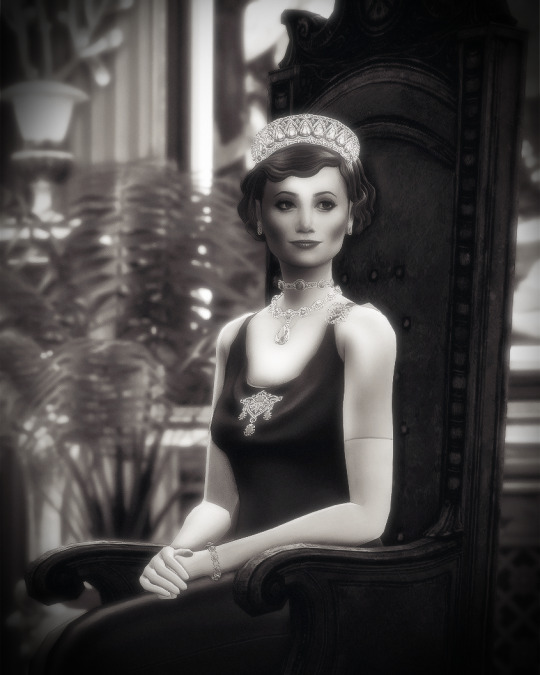
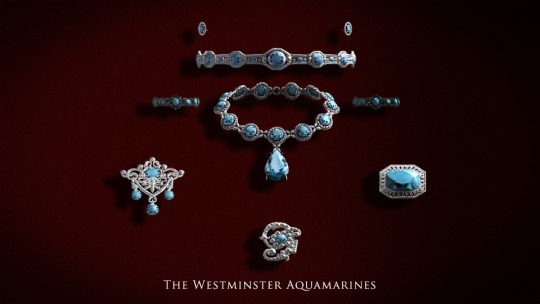
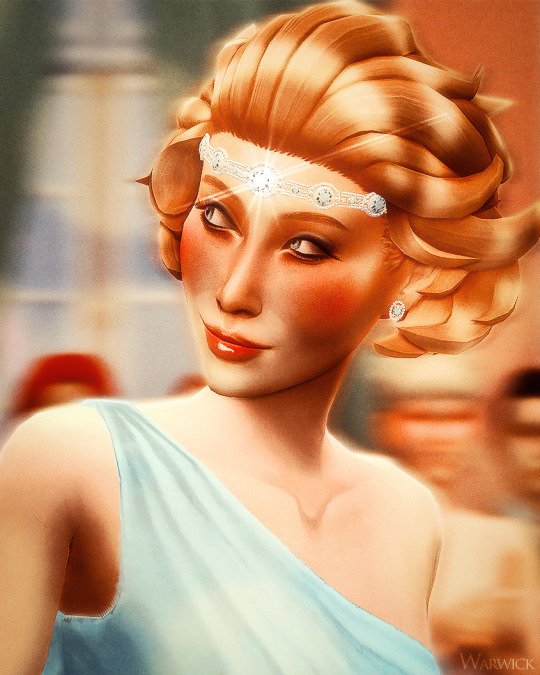

Sunderland's Royal Jewel Vault (27/∞) ♛
↬ The Westminster Aquamarines
The Sunderlandian royal family has several magnificent parures of aquamarine jewellery. One of these collections, the Westminster Aquamarines, features some of the royal family’s oldest and most iconic jewels; uncovering their history takes us back nearly two hundred years.
In 1830s, Sunderland was a lone constitutional monarchy in North America, bordered by the United States in the northeast and Mexico to the southwest. The early 19th century had seen the country’s steady expansion westward thanks to territorial acquisitions from the Spanish and British. This period of territorial and economic growth, however, was cut short by the early death of Sunderland’s Hereditary Prince in 1835.
Hereditary Prince Frederick James was just shy of thirty, the only son of King Louis III and his beloved first wife, Princess Amelia of the United Kingdom. Freddie was also the only legitimate male-line grandson of King Louis II, as a result, his death complicated Sunderland’s succession. The question of who would succeed Louis III ignited a fierce rivalry among the King’s younger brothers, as they scrambled to marry and produce an heir to the throne.
The Duke of Lennox and St. George, the King’s first brother and heir presumptive, married an obscure German princess. The Duke of Glencairn, the King’s second brother, married the daughter of a wealthy British statesman. But it was the King’s fifth brother, Prince Augustus, the Duke of Westminster, who looked for a bride closer to home.
Lady Martha Whitley was twenty years younger than her husband-to-be, a descendant of the Prussian nobility that migrated to Sunderland following the election of Prince Heinrich of Prussia as King Louis I of Sunderland, Martha hailed from one of Sunderland’s oldest aristocratic families. Unlike some of her foreign, and significantly younger, sisters-in-law Martha was shrewd and held a deep familiarity of Sunderland's court life, this was reflected in her impressive jewelry collection. On her wedding day, Martha was gifted a small box of aquamarine pendants of various shapes and sizes. As Martha’s prominence at court grew, the aquamarines became known as the Duchess of Westminster’s Aquamarines. Over the years, the Duchess incorporated the aquamarines into a few pieces of jewelry including a necklace and a pair of earrings.
The tensions surrounding Sunderland’s succession died down when the British-born Prince George of Glencairn became king in 1860. By then Westminsters had three children, Prince Louis, who became Duke of Westminster following his father’s death in 1877; Prince Thomas, and Princess Elizabeth Anne. The family was popular with nobility and the public alike, but they weren’t without their scandals.
After Prince Louis enraged King George by marrying without permission, his subsequent children were declared illegitimate and barred from inheritance. Finding a suitable wife for Prince Thomas, now heir to the Westminster Dukedom, became a top priority. In 1876, Prince Thomas met and fell in love with Princess Marie of Hanover, a male-line great-granddaughter of King George III and therefore a British princess. The couple married in 1880, but struggled to have children. In 1887, their only surviving child was born in the presence of Queen Alexandra. The little princess, given the lengthy name Alexandra Anne Martha Georgina Dagmar Gloriana Marie, would be known to history as Princess Anne of Westminster. Growing up, Anne was placed in the direct care of her Dear Granny Martha.
My grandmother was magnificent. She was kind but strict, with old-fashioned ideas about how a princess should be brought up. - Queen Anne of Sunderland, circa 1953
The Duchess of Westminster had high hopes for her only male-line granddaughter. Indeed, Anne’s maternal cousins were well-connected to the British and Danish royals, as well as the Imperial families of Russia and Germany. By the time Anne was twenty, she’d been taken on several trips to Europe, excursions she came to loathe. Anne’s anxiety worsened when she was rejected by several families. After her mother died in Austria, Anne returned from Europe “alone and feeling rather sorry for myself”.
Back in Sunderland, Anne made friends with her second cousin once-removed, Prince George, the Duke of Woodbine and eldest son of the Prince and Princess of Danforth. Over the years, the pair’s friendship developed into a romance and in 1911, King George allowed the couple to marry. That same year, the Duchess of Westminster died, and Anne inherited the largest jewel collection in the royal vault, aquamarines included.
Anne and George married in 1913. Anne, now Duchess of Woodbine, was one the most dynastically important ladies at court and she set to work reworking her grandmother’s jewels into spectacular works of art. For King George and Queen Alexandra’s 1920 Diamond Jubilee, Anne commissioned Garrard to work the aquamarines into a parure that included a necklace, a choker, two brooches, and a pair of earrings. The parure paired nicely with the aquamarine Georgiyevna Tiara, which entered the family in the early 1920s. To this day, the Georgiyevna aquamarines are often mistaken for those of the Westminster set, showing how ubiquitous they’ve become with the main-line royal family’s collection. When Anne became Queen in 1930, she wore the aquamarines. Despite her overflowing jewellery box, the aquamarines were evidently her favourite and became synonymous with her name and legacy.
The Westminster aquamarines have remained iconic long after Queen Anne’s time. Queen Irene became another famous wearer of the suite, wearing the choker as both a necklace and a headband in the 1980s. Queen Anne was an important figure to Irene during the early years of her marriage, and she wears nearly all of the jewels her grandmother-in-law left to her. In the 2010s, Tatiana, then the Princess of Danforth was seen in bits and pieces of the suite, notably the choker, signalling that the jewels will be carried on into the next generation.
Queen Anne of Sunderland, wife of King George II, wears the Westminster aquamarines with the Georgiyevna tiara for a promotional image, circa 1930
Queen Irene of Sunderland, wearing a powder blue satin evening gown along with the Westminster aquamarine choker as a headband, attends a gala dinner on April 30, 1984 in Auckland, New Zealand
#warwick.jewels#✨#not a tiara technically i don't care leave me alone#ts4#ts4 story#ts4 royal#ts4 storytelling#ts4 edit#ts4 royal legacy#ts4 legacy#ts4 royalty#ts4 monarchy#ts4 screenshots
50 notes
·
View notes
Text
The Nature-Culture Divide
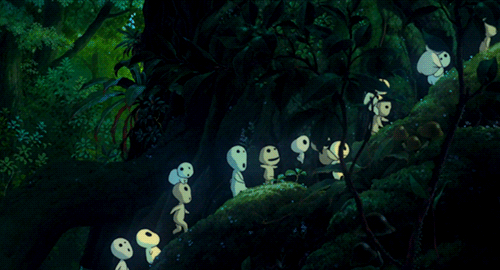
Something I have seen a lot of people within the Solarpunk sphere talk about and wonder is: "When did we stop seeing ourself as something outside of nature?" And given that I actually had a module on that (Social Geography, best module I ever had, given we had an anarchist professor!) I thought I could quickly explain this one.
So, the names come, in the end, from Latin and back when those words were considered in Latin, the difference was, that nature was a thing that was innate, while culture had volition behind it. You could change nature into culture by putting work into it.
Something that might surprise you is, that the idea of nature then was never quite big for most of European history. And let me make one thing clear: While we have these ideas also played with in Buddhist culture - especially in East Asia - the way we define it right now is a Western idea.
And that idea... Well, that idea came with colonialism. The thing many do not realize is, how much of the rules and "lines in the sand" that we use in our culture came from colonialisation, came from the desire to make "our" culture different from "theirs". It is shown in the way we eat, in the way we raise children, in the way we view gender and sexuality. And, yes, in the artificial border between nature and culture.
Before I tell you more about this, let me please say here: Yes, this is contradictive. I am aware of it. I am not the one who came up with the contradiction. White settlers did that all on their own.
When the settlers came to America they found a landscape very, very different from what they were used to from Europe. After all, Europe has been changed through human hand for at that point about 1600 years. (And for you Europeans out there: Researching how much forest your local area might have lost through the Romans is always a "fun" thing to do! Because the Romans destroyed a lot of European ancient forests.) In Europe, even at the wildest places, there was usually some evidence of human habitation - but this was not true for the Americas. Not because there were no people there, but rather because the people interacted with the environment very differently.
See, the European idea - while never quite that defined until this point - was really, really based on this thought that nature can be turned into culture. And that this transformation was in fact a good thing to happen. So, when the settlers arrived in the Americas they did not see "culture" there, only "nature" and set out to turn that "nature" into "culture".
Of course, we - modern people living today - do realize that indigenous people had in fact cultures of all sorts and that the actual difference was, that they just did not see that culture as something different from nature, rather than a part of it. Because their culture had not been influenced by Romans. But the settlers back then did not see this or rather did not want to see this. So they "cultured" the land, with the ideas about nature and culture being further formalized at that point.
It kinda stayed like this until the late 19th century, when Madison Grant, the originator of eco fascism came to be influencial. And now he saw something that the settlers until this point were unable to see: The indigenous people do stuff with the nature around them! They change it! For example through controlled burning of forests and things like that.
And this made Madison Grant very angry, because he was very much off the opinion that nature should be "unsoiled" by human hands. So... he made sure that those indigenous people got once more pushed out of the areas they were living, with the same areas being declared natural parks and no longer interfered with by humans (except, of course, all the tourists who destroyed it bit by bit). Leading... To a lot more wild fires.
So, where does this leave us in terms of the culture/nature divide?
Well, the idea has been there since ancient Rome and has very much influenced how much we view nature as its own thing. But within Rome nature was still not quite seen as the opposite of culture - as one could turn into the other. Under the Roman view an abandoned house or a field that was no longer cared for would turn back into nature, while anything could become culture just by interacting with humans.
The modern view really came through colonialism and the way colonialist did not understand (and did not want to understand) indigenous practices. This made people more and more drift towards the understanding of humans being an entirely different thing from nature.
But this is wrong, of course. We are part of nature. We are just animals with fingers and slightly larger brains. And many indigenous cultures understood this. In the end it was the greed of some that made us loose this connection to nature. And that is exactly why we are in this climate change related mess right now.

#solarpunk#history#culture#nature#culture-nature divide#colonialism#anti colonialism#indigenous knowledge#indigenous people#national parks
173 notes
·
View notes